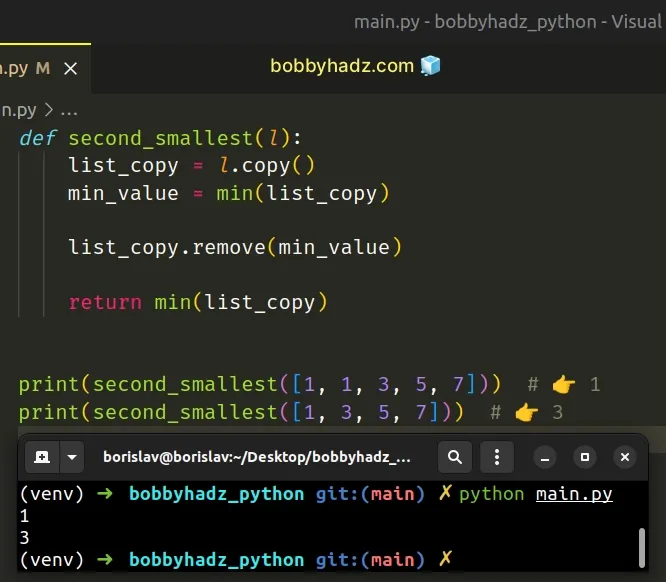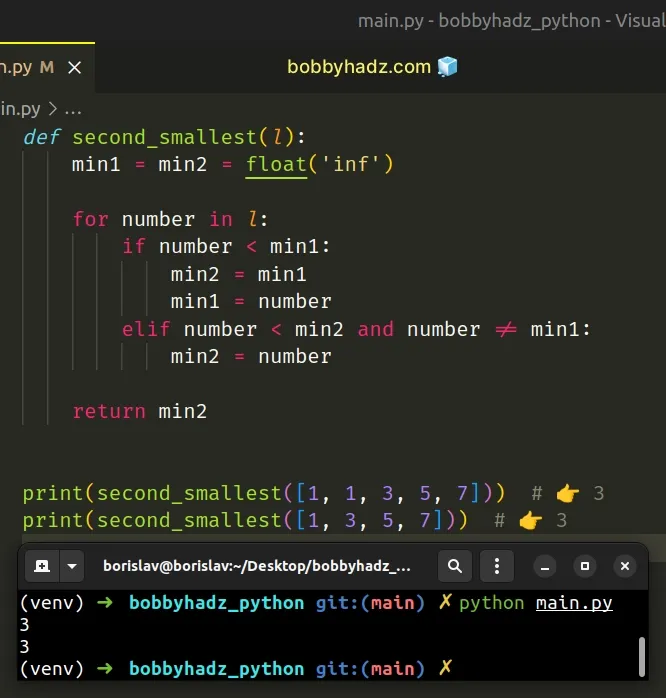Find second Smallest or Largest number in a List in Python
Last updated: Apr 10, 2024
Reading time·6 min

# Table of Contents
- Find the second smallest number in a List in Python
- Find the second largest number in a List in Python
# Find the second smallest number in a List in Python
To find the second smallest number in a list:
- Use the
set()class to convert the list to aset. - Use the
sorted()function to get a sorted list. - Access the list item at index
1to get the second smallest number.
def second_smallest(l): return sorted(set(l))[1] print(second_smallest([1, 1, 3, 5, 7])) # 👉️ 3 print(second_smallest([1, 3, 5, 7])) # 👉️ 3

If you need to find the second largest number in a list, click on the following subheading:
We used the set() class
to convert the list to a set to remove any duplicates.
The sorted function returns a new sorted list from the items in the iterable.
The last step is to access the list element at index 1.
0, and the last item has an index of -1 or len(my_list) - 1.If you consider 1 to be the second smallest number in the list, use the next
code snippet.
# Find the second smallest number in a List using heapq.nsmallest()
Alternatively, you can use the heapq.nsmallest() method.
The heapq.nsmallest() method returns a list with the N smallest elements from
the provided iterable.
import heapq second_smallest = heapq.nsmallest(2, [1, 1, 3, 5, 7])[1] print(second_smallest) # 👉️ 1 second_smallest = heapq.nsmallest(2, [1, 3, 5, 7])[1] print(second_smallest) # 👉️ 3
The heapq.nsmallest() method returns a list with the N smallest elements from the provided iterable.
We used the method to get the 2 smallest numbers in the list and accessed the
list element at index 1 to get the second smallest number.
import heapq print(heapq.nsmallest(2, [1, 3, 5, 7])) # 👉️ [1, 3] print(heapq.nsmallest(2, [1, 3, 5, 7])[1]) # 👉️ 3
Alternatively, you can use the list.remove() method.
# Find the second smallest number in a List using list.remove()
This is a three-step process:
- Use the
list.copy()method to create a copy of the list. - Use the
list.remove()method to remove the min value from the copy. - Use the
min()function to get the second smallest value.
def second_smallest(l): list_copy = l.copy() min_value = min(list_copy) list_copy.remove(min_value) return min(list_copy) print(second_smallest([1, 1, 3, 5, 7])) # 👉️ 1 print(second_smallest([1, 3, 5, 7])) # 👉️ 3

We used the list.copy() method to create a copy of the list.
The min() function returns the smallest item in an iterable or the smallest of two or more arguments.
my_list = [10, 5, 20] result = min(my_list) print(result) # 👉️ 5
We then used the list.remove() method to remove the min value from the copy of
the list.
The list.remove() method removes the first item from the list whose value is equal to the passed-in argument.
The last step is to pass the copy of the list to the min() function to get the
second smallest number.
Alternatively, you can use a for loop.
# Find the second smallest number in a List using a for loop
This is a three-step process:
- Declare a variable for the smallest and second smallest numbers.
- Use a
forloop to iterate over the list. - Use comparison operators to find the second smallest number.
def second_smallest(l): min1 = min2 = float('inf') for number in l: if number < min1: min2 = min1 min1 = number elif number < min2 and number != min1: min2 = number return min2 print(second_smallest([1, 1, 3, 5, 7])) # 👉️ 3 print(second_smallest([1, 3, 5, 7])) # 👉️ 3

We used a for loop to iterate over the list of numbers.
min1 variable represents the smallest number in the list and the min2 variable represents the second smallest number.On each iteration, we check if the current number is less than the min1
variable.
If the condition is met, we:
- set the
min2variable to the current value ofmin1 - set
min1to the number of the current iteration
Our elif statement checks if the current number is less than min2 and is not
equal to min1.
If the number is greater than min1 and less than min2, then we assign the
current number to the min2 variable.
After the last iteration, the min2 variable stores the second smallest number
in the list.
# Find the second largest number in a List in Python
To find the second largest number in a list:
- Use the
set()class to convert the list to aset. - Use the
sorted()function to get a sorted list. - Access the list item at index
-2to get the second largest number.
def second_largest(l): return sorted(set(l))[-2] my_list = [2, 4, 6, 8, 8] print(second_largest(my_list)) # 👉️ 6
We used the set() class to convert the list to a set to remove any
duplicates.
The sorted() function returns a new sorted list from the items in the iterable.
The last step is to access the list element at index -2.
my_list[-1] returns the last item in the list and my_list[-2] returns the second to last item.# Find the second largest number in a List using heapq.nlargest()
If you consider 8 to be the second largest number in the list, use the next
code snippet.
The heapq.nlargest() method returns a list with the N largest elements from
the provided iterable.
import heapq second_largest = heapq.nlargest(2, [2, 4, 6, 8, 8])[1] print(second_largest) # 👉️ 8 second_largest = heapq.nlargest(2, [2, 4, 6, 8])[1] print(second_largest) # 👉️ 6
The heapq.nlargest() method returns a list with the N largest elements from the provided iterable.
We used the method to get the 2 largest numbers in the list and accessed the
list element at index 1 to get the second largest number.
import heapq print(heapq.nlargest(2, [2, 4, 6, 8])) # 👉️ [8, 6] print(heapq.nlargest(2, [2, 4, 6, 8])[1]) # 👉️ 6
0, and the last item has an index of -1 or len(my_list) - 1.Alternatively, you can use the list.remove() method.
# Find the second largest number in a List using list.remove()
This is a three-step process:
- Use the
list.copy()method to create a copy of the list. - Use the
list.remove()method to remove the max value from the copy. - Use the
max()function to get the second max value.
def second_largest(l): list_copy = l.copy() max_value = max(list_copy) list_copy.remove(max_value) return max(list_copy) print(second_largest([2, 4, 6, 8])) # 👉️ 6 print(second_largest([2, 4, 6, 8, 8])) # 👉️ 8
We used the list.copy() method to create a copy of the list.
The max() function returns the largest item in an iterable or the largest of two or more arguments.
my_list = [15, 45, 30] result = max(my_list) print(result) # 👉️ 45
We then used the list.remove() method to remove the max value from the copy of
the list.
The list.remove() method removes the first item from the list whose value is equal to the passed-in argument.
The last step is to pass the copy of the list to the max() function to get the
second largest number.
Alternatively, you can use a for loop.
# Find the second largest number in a List using a for loop
This is a three-step process:
- Declare a variable for the largest and second largest numbers.
- Use a
forloop to iterate over the list. - Use comparison operators to find the second largest number.
def second_largest(l): max1 = max2 = float('-inf') for number in l: if number > max1: max2 = max1 max1 = number elif number > max2 and number != max1: max2 = number return max2 print(second_largest([2, 4, 6, 8])) # 👉️ 6 print(second_largest([2, 4, 6, 8, 8])) # 👉️ 6
We used a for loop to iterate over the list of numbers.
max1 variable represents the largest number in the list and the max2 variable represents the second largest number.On each iteration, we check if the current number is greater than the max1
variable.
If the condition is met, we:
- set the
max2variable to the current value ofmax1 - set
max1to the number of the current iteration
Our elif statement checks if the current number is greater than max2 and is
not equal to max1.
If the number is less than max1 and greater than max2, then we assign the
current number to the max2 variable.
After the last iteration, the max2 variable stores the second largest number
in the list.
# Additional Resources
You can learn more about the related topics by checking out the following tutorials:
- Find the ones, tens, hundreds and thousands digits in Python
- Find the indices of duplicate items in a List in Python
- Find Max and Min in List without max() and min() in Python
- Find Min and Max values in Tuple or List of Tuples in Python
- Find the most/least common element in a List in Python
- Find the most frequent character in a String in Python
- Find object(s) in a List of objects in Python

